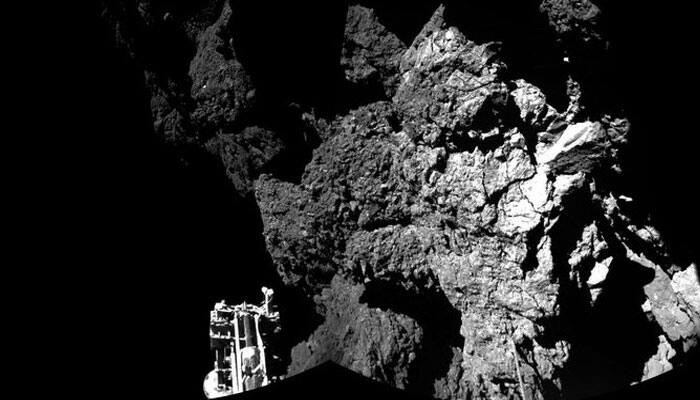Paris: Europe`s science probe Philae sent home a treasure trove of data from a comet heading towards the Sun before falling silent as its power ran out, mission control said Saturday.
Crowning a historic feat, the robot lab streamed data from its experiments back to its mother ship Rosetta in the final hours before its battery ran down.
This included the outcome of an eagerly-waited chemistry test of a sample drilled from the comet`s icy and dusty surface, scientists said.
"Rosetta`s lander has completed its primary science mission," the European Space Agency (ESA) said.
Lacking power, its instruments and most systems went into standby mode after three days of non-stop work, sending back data that will keep scientists busy for years.
"The data collected by Philae and Rosetta is set to make this mission a game-changer in cometary science," said Matt Taylor, Rosetta project scientist.
Philae had landed in a dark shadow after a bouncy triple touchdown Wednesday.
It did not get enough sunlight to recharge its batteries sufficiently to extend its mission beyond its initial 60-hour work programme.
Mission engineers do not rule out making contact with the lander in the coming months as Comet 67P/Churyumov-Gerasimenko moves closer to the Sun.
Conceived more than 20 years ago, the Rosetta mission aims at shedding light on the origins of the Solar System 4.6 billion years ago, and maybe even life on Earth.
A theory gaining ground in astrophysics is that the fledgling Earth was pounded by these bodies of cosmic ice and carbon-rich dust, seeding our planet with the basics to start life.
Rosetta and its payload travelled more than six billion kilometres (3.75 billion miles), racing around the inner Solar System before they caught up with the comet in August this year.
On Wednesday, Philae bade farewell to its mother ship and descended to a comet travelling at 18 kilometres (11 miles) per second, 510 million kilometres (320 million miles) from Earth.
The touchdown did not go entirely as planned -- hardly a surprise in an operation some gloomily predicted had only a one-in-two chance of success.
Philae landed smack in the middle of its targeted site, but a pair of anchoring harpoons failed to deploy.
It rebounded, touched down again, bounced up once more and then landed for the third time at a place believed to be about a kilometre (half a mile) from the landing site.
Philae found itself in the shadow of a cliff, tilted at an angle that left one of its three legs pointed to the sky.
Weighing 100 kilos (220 pounds) on Earth, Philae has a mass of just one gramme (0.03 of an ounce) -- less than a feather -- on the low-gravity, four-kilometre comet.
That meant just a jolt could have caused it to drift off into space.
And lack of sunlight for its solar panels meant it had to survive on a battery with a charge of around 60 hours, enough to carry out its scheduled scientific work.Stacked against the odds, the scientists resorted to every trick possible to use power miserly and keep Rosetta working without causing it to drift away.
Using the lander`s toolkit of 10 instruments, they started with passive observation -- taking pictures, measuring the comet`s density, temperature, and internal structure, "sniffing" molecules of gas from its surface -- that would not move the craft.
Finally, in the most important but riskiest experiment of all, they drilled a core of material out of the comet surface to analyse its chemical signature.
All the data had to be stored and dispatched back to Rosetta as the power indicators shrank towards the red zone.
"We received everything," mission scientist Jean-Pierre Bibring told AFP. "The word is `fabulous,` just `fabulous.`
The team`s eagerly-awaited first report will be made at a meeting of the American Geophysical Union (AGU) in San Francisco next month.
The "67P" comet is due to loop around the Sun next year, flaring gas from its head and leaving a spectacular icy trail of ice from water stripped from its surface.
Rosetta will escort it until the comet heads back out towards the depths of the Solar System in December 2015.
















